My fly boxes
{{start}}
The number of fly boxes you carry is obviously one of personal choice. One difficulty you may encounter when you are setting up your fly boxes is which flies you should include, and how many flies you should carry in your fly box or boxes. The last thing you want to be doing is standing on the bank of a river madly pulling flies out to find a fly you know is there . . .somewhere, but it isn’t where you expected to find it or you fly box or boxes are so crowded with flies that the one you are desperately looking for is hidden away . . . somewhere.
{{end}}
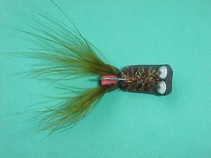
{{+1}}Wiggle frog – Chatto’s original{{-1}}
{{start}}
You can fish this fly on an intermediate or faster sinking line but my preference is to fish it on a floating line so that it swims just below the surface. On a floating line the best technique for fishing the fly is to give it one or two short strips and then rest it for a moment whilst it comes back to the surface. Rest it there for a few more seconds and then repeat the process.{{end}}
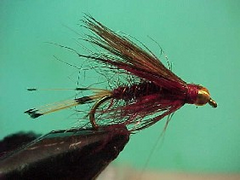
{{+1}}Bead head mallard & claret{{-1}}
{{start}}
A variation on my Soft Winged Bob flies is to turn them into anchor flies for use as the point fly in a team of loch style flies. They are attractive to fish and because of the smaller size and additional weight they sink faster than most flies and keep my leader straight making it easier to keep in contact with my dropper flies. The weigh is a 2mm gold, copper or black tungsten bead (or brass bead and 8 wraps of .015mm lead on the front half of the hook shank).{{end}}
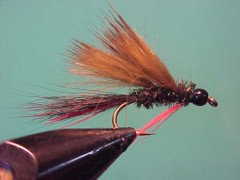
{{+1}}Bead head bag fly{{-1}}
{{start}}
I now tie it in three versions. The first is as set out in the recipe below. Originally designed for red fin feeders it has become my favourite bag fly overall. It has red hackle fibres tied under the tail and as a light beard and over time I found these a great trigger point for all versions. The second version is all brown except for the red beard and is a great alternative to a Diawl Back. Finally I tie a bead head version for when I want to fish a little deeper.{{end}}
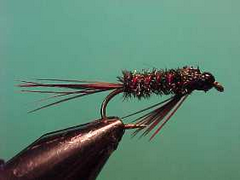
{{+1}}Bead head diawl bach{{-1}}
{{start}}
I tie it both with and without weight and find the addition of a small black tungsten bead makes it a handy anchor fly or a good prospecting fly in running water.{{end}}
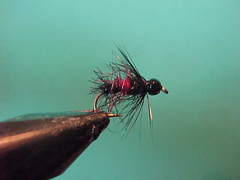
{{+1}}Bead head bibio variant{{-1}}
{{start}}
A bead head version is not a bad idea either. Swap over to a slightly longer hook such as a Tiemco 3769, start with a small black tungsten bead and continue with the recipe below. My version below varies from the original tie in that it doesn't include a body hackle. Instead the body is dubbed with seal fur dubbing which has been teased out in step 'D' with a Velcro rub.{{end}}
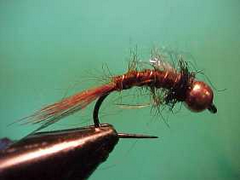
{{+1}}TBH chocolate caddis nymph{{-1}}
{{start}}
Caddis are are common throughout the year but with the greater concentrations occurring from September through to March. They inhabit both running and still water and are a significant food source for most trout often reputed to represent up to 30% of a trout's diet.{{end}}
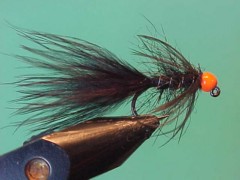
{{+1}}River Jig Bugger – CDC orange TBH and black{{-1}}
{{start}}
This is really good representation of a woolly bugger for river fishing. It sinks well and the jig hook encourages the fly to bounce along the bottom hook point up which of course mitigates snags. Whilst I have set the recipe out below for the brown, black and olive jig buggers I also tie my sparkle bugger and skirted buggers in the form of a jig bugger as shown in the photos below.{{end}}
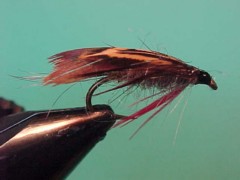
{{+1}}Murdoch{{-1}}
{{start}}
Another old fly this little beauty has its origins on the salmon and trout streams of Ireland probably around the 1820's. Its alternative name of 'hares ear and red' gives away its ancestry. Early versions of the fly presented were no more than a gold ribbed hares ear with a woodcock type wing tied on top. Over time the recipe has evolved.{{end}}
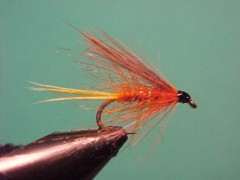
{{+1}}Dunkeld – Chatto’s fuzzeled variant{{-1}}
{{start}}
The Dunkeld is certainly one of my top 5 middle dropper flies for lock style fly fishing. Until 18 months ago I was using a version of the Dunkeld that had a hackle Palmered along the body as in the original. At that time I was experimenting with "fuzzeled" bodies an an alternative to bodies with a Palmered hackle and applied that technique to this fly with immediate success.{{end}}
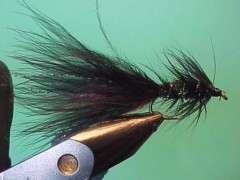
{{+1}}Sparkle bugger{{-1}}
{{start}}
Woolly buggers and their variants would have to be close to the quintessential wet fly. This woolly bugger version is one of my favourate late season still water flies.{{end}}













